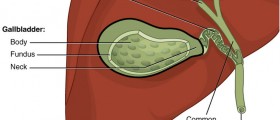Malabsorption is insufficient absorption of nutrients. This medical condition is also accompanied by vitamin and mineral deficiency. There is a variety of medical conditions that can lead to malabsorption. They are basically connected with improper functioning of certain parts of the gastrointestinal tract.
Bassen-Kornzweig Syndrome
This syndrome is a hereditary condition and features inappropriate absorption of fats. Without a sufficient amount of fats, the body cannot develop and function properly. This syndrome predominantly affects men, and the actual cause lies in the defect of one or two specific genes. Fats are of great importance for the nervous and muscular systems.
The symptoms of Bassen-Kornzweig Syndrome include inappropriate development, the presence of stool rich in fats, muscular problems such as bad coordination, and weakness of muscles. Additionally, patients may complain about problems with vision and speech.

Biliar Atresia
Biliar atresia is a congenital disease. It features inadequate development of the bile ducts. The consequence of this is accumulation of the bile inside the liver. The patient develops cirrhosis of the liver, and, in the terminal stage of the disease, liver failure.
Bile is essential for the absorption of fats. In people who are suffering from biliary atresia, bile cannot reach the intestines, therefore the fats cannot be properly absorbed.
Celiac Disease
Celiac disease is another medical condition that causes malabsorption. Namely, the patient with celiac disease cannot tolerate gluten, a substance that is present in certain foods. Intake of food rich in gluten leads to the destruction of the intestinal villi, and if large portions of the intestines are damaged absorption of nutrients becomes insufficient.
However, if the disease is found on time just by simple elimination of the food rich in gluten, one can prevent excessive damage to the intestine and reduce the chance of malabsorption.
Intestinal Parasites
Some intestinal parasites, including Giardia lamblia, Necator americanus, and Strongyloides stercoralis, can interfere with digestion of the food. They can either directly 'steal' the food from the host or their presence is what makes absorption difficult.
In many patients suffering from intestinal parasites, malabsorption can be the only symptom of the disease, and it can lead the patient to see his/ her doctor.
Pancreatitis
Destruction of pancreatic tissue, especially if it is caused by autoimmune diseases, as well as acute and chronic inflammation of this gland, in all cases, leads to malabsorption. This can be explained by the fact that the structure of the pancreas has been significantly damaged by inflammation, and the gland cannot produce enzymes necessary for digestion. Malabsorption particularly affects fats since the purpose of pancreatic enzymes is the digestion of these substances.
- Regardless of the cause, malabsorption syndrome refers to the clinical picture comprising diarrhea, steatorrhea, malnutrition, weight loss, abdominal pain, and anemia. Undigested food produces diarrhea, due to its voluminous effect in the bowel lumen. Although all three major nutrients (fat, carbohydrate, and protein) may be malabsorbed, clinical symptoms usually only develop with carbohydrate and fat malabsorption.
- The indication for a small intestinal biopsy is usually the work-up of malabsorption, a clinicopathologic picture caused by a number of infectious and noninfectious inflammatory conditions. The biopsy is generally taken through an endoscope, by either forceps or suction, from the duodenum or proximal jejunum. Depending upon the underlying condition, morphological abnormalities are seen in malabsorption range from normal mucosa with increased intraepithelial lymphocytes (gluten-sensitive enteropathy, viral gastroenteritis, food allergies, etc.), villous shortening with crypt hyperplasia (celiac disease (CD), treated CD, tropical sprue, and bacterial overgrowth), to completely flat mucosa (CD, refractory sprue, enteropathy-induced T-cell lymphoma, and autoimmune enteropathy).
- Infectious agents that affect gastrointestinal tract can be grouped as food-borne and water-borne bacteria, opportunistic infections (bacterial, fungal, and viral), viral infections (extremely rarely biopsied), and parasitic and helminthic infections. The majority of these infections are, however, self-limited. Although biopsy is more invasive, the use of this procedure allows detection of other causes, including Whipple's disease, other protozoan forms of diarrhea (e.g., cryptosporidiosis, isosporiasis, or cyclosporiasis), Crohn's disease, or lymphoma that may also present as diarrhea and malabsorption.
- medlineplus.gov/ency/article/000299.htm
- medlineplus.gov/malabsorptionsyndromes.html
- Photo courtesy of www.scientificanimations.com via Wikimedia Commons: commons.wikimedia.org/wiki/File:Inflammed_mucous_layer_of_the_intestinal_villi_depicting_Celiac_disease.jpg

















Your thoughts on this
Loading...